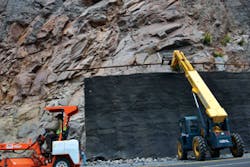Keeping Slopes Aligned With Geogrid Technology
Whether seen in the gradual downslope movement of individual grains of sand dragged toward the ocean with each wave from the sea, or a mammoth mountainside boulder, triggered by the weight of a snowpack into a tumbling avalanche, slope instability is a process of nature. Stopping slope instability means fighting gravity. And gravity, the force behind slope instability, operates mercilessly, whether it does us good or not, continually shaping and shifting the contours of the Earth. Because it occurs everywhere, all the time, it mostly goes unnoticed because there’s no one there to see it happen. But when slope instability occurs on a hillside that either houses or overlooks some valued asset, it becomes a matter of great concern.
One of the earliest methods discovered to prevent something from falling down was to lean something else against it, but that requires a backstop itself to lean against, and on sloping terrain that backstop is often not available. However, erosion control specialists can now do much more than merely choosing what objects to set in the path of a rockfall or landslide. An expanding palette of geogrid solutions can provide an integrated approach to geotechnical systems that can arrest instability at its root and preserve valuable assets while managing problematic slopes.
Rock in the Road
The Washington State Department of Transportation (WSDOT) has a system to evaluate the risks of rockslides and slope instability along its state highway network. According to Corie Henke, field engineer with WSDOT, the highway agency evaluates slopes along the roadsides using a rating system that assigns each stretch of road statewide a number designating its risk for slope instability.
“Part of the rating system is whether or not there have been incidents in the area,” says Henke. For example, there had been incidents of large pieces of rock and debris ending up in the middle of the road on sections of Highway 12, the only numbered highway to span the entire state, which eventually carries traffic back and forth as far to the east as Detroit, MI. Rockslides on Highway 12 near Clear Creek, WA, in the mountainous Cascades region of the state placed the stretch of road high on the priority list for slope remediation projects. The heavily trafficked scenic roadway cuts through the steeply sloped terrain of the Cascade Mountains ranges at elevations between 2,600 and 4,000 feet.
Henke has been field engineer on a multiphase project to keep Highway 12 clear of debris, safe, and passable by stabilizing the slopes of the hills into which it was carved. WSDOT recently completed a major slope stabilization project between White Pass, a town widely popular as a skiing attraction, and Clear Creek Falls with its idyllic lakeside vistas.
Although the primary goal of the project was keeping the road open and safe, another important goal was to preserve the natural look and aesthetics of the surrounding environment.
“The most dominant issue was large rock debris ending up in the road,” says Henke. In carrying out the project, the intent was “not to change the terrain of the rock face.” To meet these two almost contradictory goals, project designers planned to hold the stone-faced slopes in place with wire mesh.
Breaking Bad Rocks
Before wrapping the stones in the mesh, crews would need to go in and deal with loose rock, a job that Henke says demands considerable skill, not only to maintain one’s footing on precarious terrain, but also to identify where to apply the force needed to scale away treacherous shards of stone and where to leave nature to her own devices. “Our rock scalers are required to have 2,000 hours of experience before they are approved to work on highway projects,” says Henke.
Clambering over the rock faces wielding a steel rod 6 feet in length, the scalers must break loose all of the stone they might encounter that appears susceptible to spontaneous rock falls that could imperil the roadway or litter it with debris ranging from stones to branches and boulders. The job requires physical stamina to be sure, but also discretion. Henke says a good scaler also has to know when to stop. “Unless there is a large rock that our geotech department says needs to come down,” he says, a rule of thumb in scaling is to break off only those stones that one person can remove with the 6-foot scaling bar.
“If you can’t get it to break loose with that much force, it is probably not going to be a culprit in a typical rock fall,” he says.
At this stage of a stabilization project, says Henke, the biggest danger is overscaling: “If you take out too much of the rock at the toe of the rock face, the only fix is that you have to go up and remove the overhang above.” Henke believes the most efficient way to work is to avoid that trouble in the first place by establishing “a good relationship with the scaling personnel and making sure they don’t overwork the rock.”
Once the scaling had been completed on the White Pass project, the project team began installing chain link wire mesh to contain any rock that by force of nature might become disengaged and tumble down, instigating a potential cascade of rock fall onto the roadway below.


